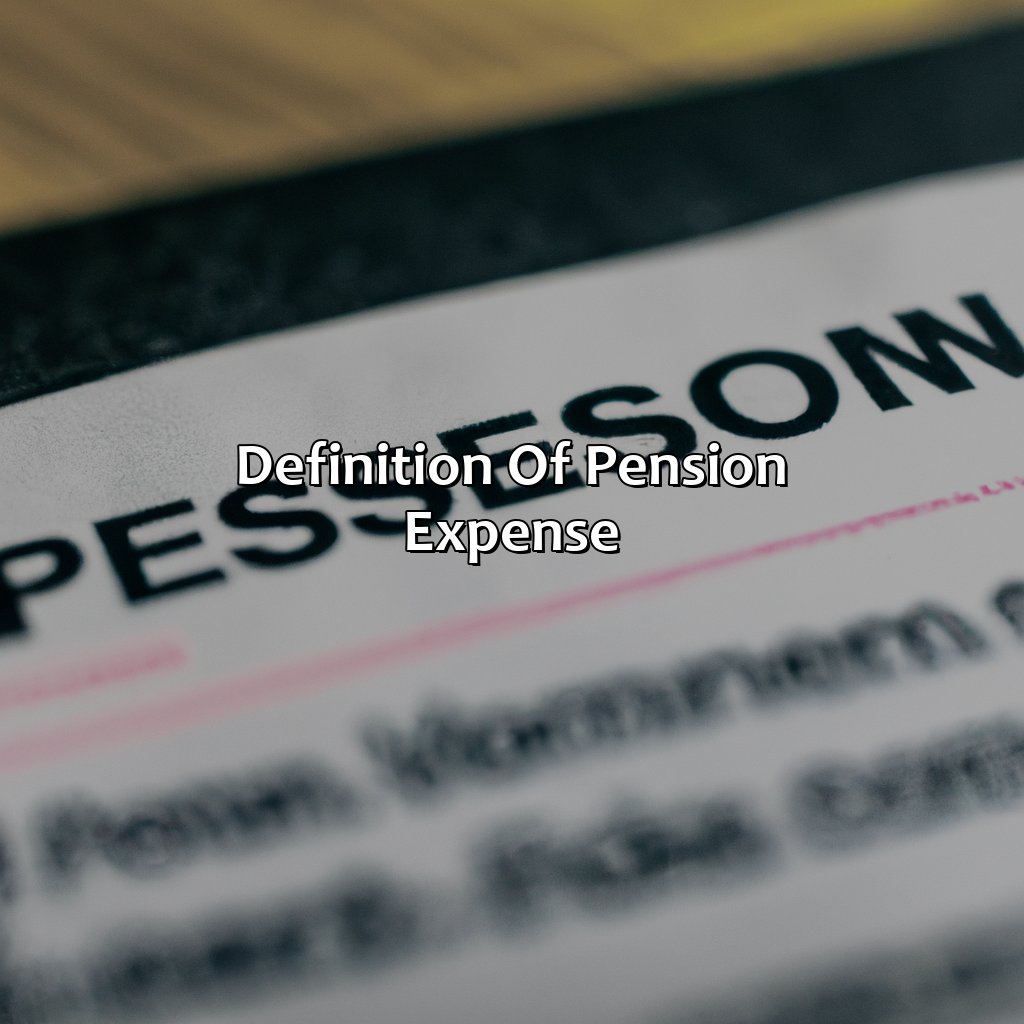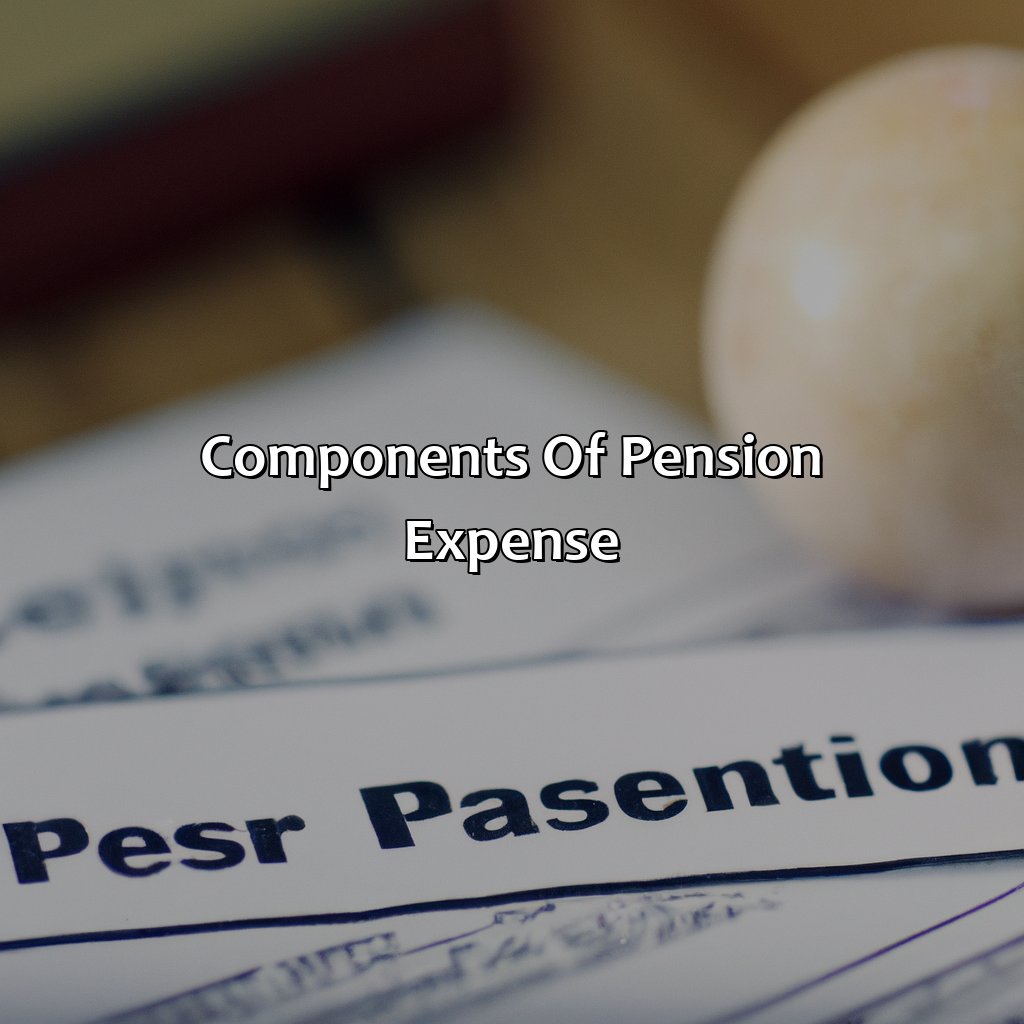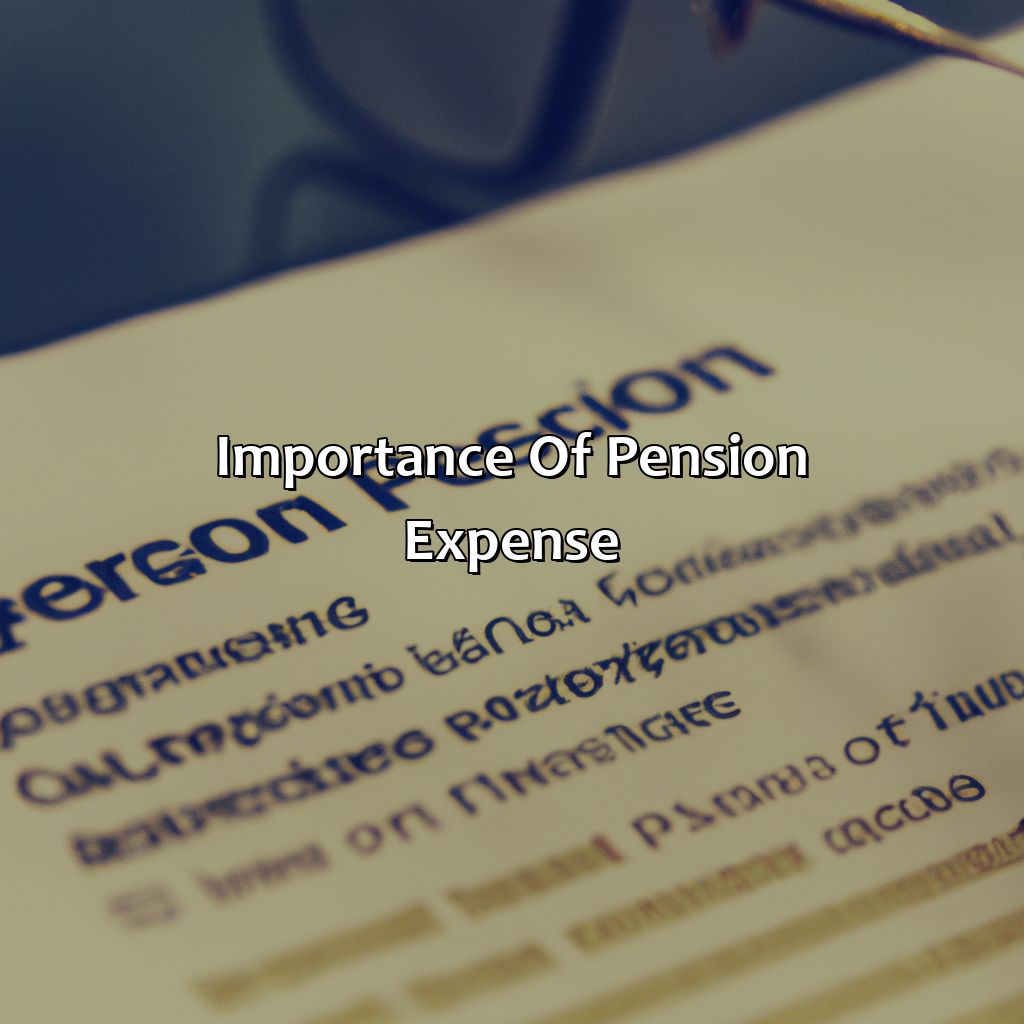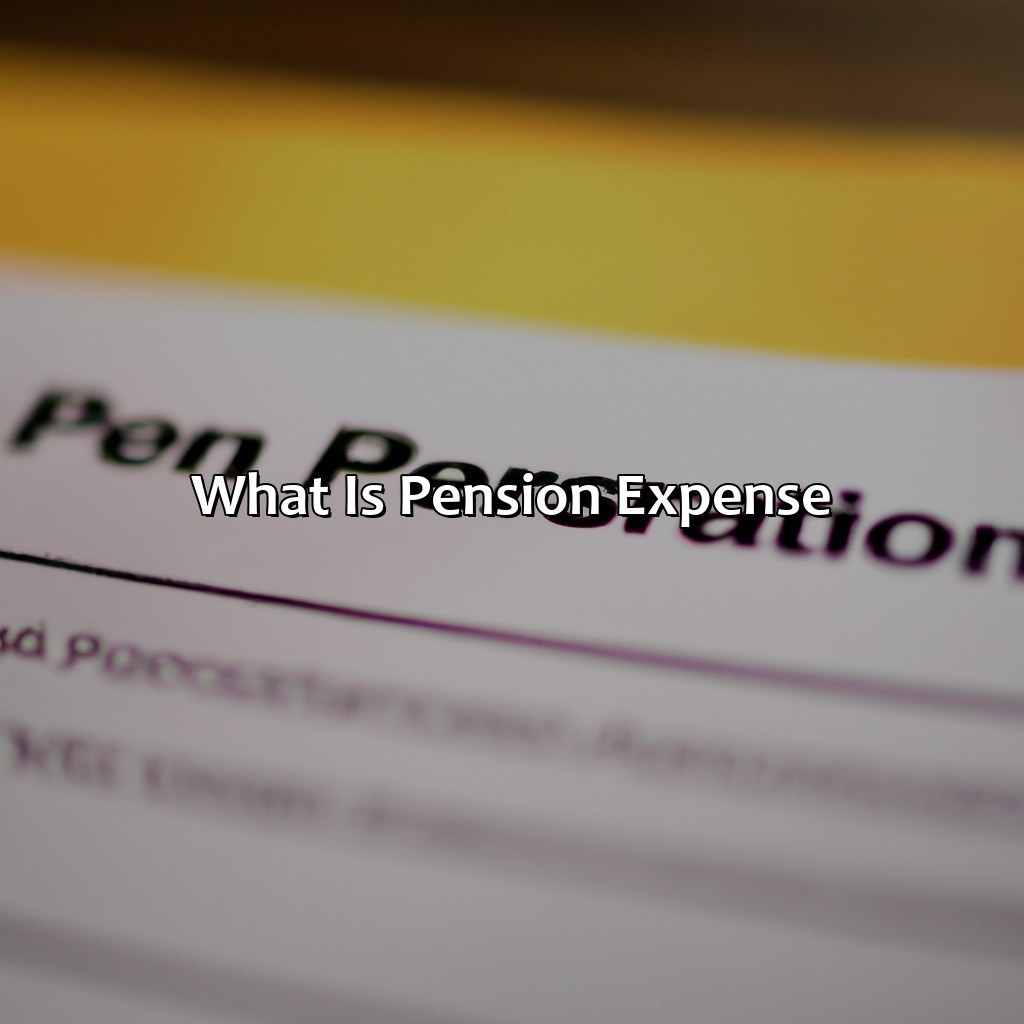What Is Pension Expense?
Key Takeaway:
- Pension expense is the cost incurred by a company to provide retirement benefits to its employees. It includes various components such as service cost, interest cost, expected return on plan assets, amortization of prior service cost, and amortization of net gain or loss.
- The components of pension expense have a significant impact on a company’s financial statements, particularly its income statement and balance sheet. The recognition of pension expense can affect a company’s net income, total assets, and liabilities.
- In addition to its financial impact, pension expense can also affect a company’s reputation as it reflects its commitment to its employees’ welfare. Companies with sound pension plans are likely to attract and retain top talent, boosting their long-term success.
Are you worried about how to start planning for your retirement? Pension expense can be a useful tool to meet your future financial goals. You can learn the basics of how to calculate your pension expense and make a plan to secure your future.
Definition of Pension Expense
Pension expense refers to the cost that an organization incurs for providing retirement benefits to its employees. This cost includes contributions made by the employer towards the pension plan, as well as any other expenses related to the plan administration and management. The rules governing the calculation and reporting of pension expense are complex and may vary based on the type of plan and the financial reporting standards used.
In addition to the basic calculation of pension expense, companies may also be required to make additional disclosures related to the plan’s assets, liabilities, and performance. These disclosures are significant because they provide insights into the overall financial health of the organization and its ability to meet its long-term obligations. If you are curious about how many pension plans are there in the US, check out this resource.
Pro Tip: Employers should regularly review and evaluate their pension plans to ensure that they remain financially sustainable and aligned with the company’s long-term goals.

Image credits: retiregenz.com by David Woodhock
Components of Pension Expense
It’s essential to understand the components of pension expense. There are sub-sections:
- Service cost
- Interest cost
- Expected return on plan assets
- Amortization of prior service cost
- Amortization of net gain or loss
Knowing each part is key for accurate calculations. They all represent different elements of the pension plan. To avoid errors, it’s crucial to comprehend them.

Image credits: retiregenz.com by Adam Jones
Service Cost
When calculating pension expenses, service cost refers to the present value of future benefits earned by employees during the current accounting period. This amount is based on actuarial assumptions such as employee demographics, salary increases, and expected returns on pension plan assets. Service cost is a key component of pension expense as it represents the ongoing cost of providing retirement benefits to employees.
In addition to service cost, other components of pension expense include:
- Interest cost, which is the expense incurred from the increase in present value of pension obligations due to the passage of time
- Amortization of past service costs or gains/losses in prior periods
- The total pension expense also includes expected return on assets and changes in actuarial assumptions.
To properly manage pension expenses, companies may consider adjusting their plan design, increasing contributions to fund the plan, or exploring alternative retirement benefits. Implementing these strategies can help reduce overall costs and better align with company financial goals while still providing valuable retirement benefits for employees.
If only our interest in retirement accounts could generate the same amount as the interest cost of pension expense.
Interest Cost
The portion of the pension expense representing the interest owed on the projected benefit obligation is known as Cost of Pension Obligation. It reflects the rate at which beneficiaries’ benefits increase with time and are discounted back to their present value. Interest costs depend on several factors: the projected benefit obligation, the discount rate used to derive its present value, and actual returns earned on plan assets.
The interest cost has a significant impact on the overall calculation of pension expense. In cases where the discount rate is low, for example, there will be a more significant interest cost to report. On the other hand, high expected rates of return on plan assets can offset an already higher-than-anticipated interest cost. If you want to learn more about how a pension fund works, click here.
While remaining steady over a certain period (the amount accruing due annually), Interest Cost changes as part of different calculations within this component in various types of pensions or plans.
Pro Tip: Stay updated with changes in actuarial assumptions that could correct your estimates and preserve you from overstating or understating costs. Who needs a crystal ball when you have expected returns on plan assets to predict the future of your pension expenses?
Expected Return on Plan Assets
Expected return on the investments held by a pension plan is an important component of pension expense. The income earned on these investments can offset some of the costs associated with providing benefits to employees.
In the table below, we outline the expected and actual returns on plan assets for XYZ Company’s pension plan.
| Asset Class | Expected Return (%) | Actual Return (%) |
|---|---|---|
| Equities | 7 | 5 |
| Fixed Income Securities | 4 | 3 |
It is essential to note that this expected return serves as a baseline for determining whether a plan s investment performance is satisfactory or not.
While plan sponsors may estimate their anticipated ROI based on past performances, it can vary because of broad market fluctuations and individual investor decisions.
Understanding and predicting this component of pension expense demands the thorough and thoughtful analysis of economic as well as market conditions. If you are wondering what is ee pension, it refers to the employer’s contribution to an employee’s pension plan.
Investment choices made by pension plan fiduciaries could have long-term impacts on the funded status of plans, employees’ benefits, and pension obligations held by employers.
Overall, in today’s market with low-interest rates and an uncertain equities market, estimating expected returns becomes more crucial than it has ever been before.
Amortizing prior service cost is like trying to pay off a debt to your past self for making promises you couldn’t keep.
Amortization of Prior Service Cost
Amortization of the Cost of Benefits Earned in Prior Years is the allocation of the total expense related to employee service in prior periods over those employees’ remaining future service years. The amount of amortization is determined using several actuarial assumptions, such as attrition and mortality rates, expected return on plan assets, and discount rate.
The table below depicts an example of how Amortization of Prior Service Cost works.
| Year | Beginning PSC | Amortization | Ending PSC |
|---|---|---|---|
| 1 | $50,000 | $5,000 | $45,000 |
| 2 | $45,000 | $4,500 | $40,500 |
In year one, the Beginning PSC represents the net value at which benefits earned during a past period are recorded. In this case, it is $50k. The Amortization for year one is calculated based on the employer’s actuarial assumptions which further reduces the previous year’s total cost by $5k resulting in an ending balance of $45k. This process continues until all PSCs have been amortized.
\n
Learn more about ER Pension and how it works.
It is important to note that employers must record Pension Expense and liabilities on their financial statements as a result of defined benefit plans. If you’re wondering who manages pension funds, it can vary depending on the specific company or organization. Some may have an in-house team dedicated to managing their pension funds, while others may outsource to third-party managers.
Pro Tip: Understanding how Actuarial Assumptions are utilized while accessing Pension Costs can help companies effectively manage their Pension Plans. If you’re wondering which of the following IRAs provides a pension for employees, click the link to learn more.
Amortization of Net Gain or Loss: Where the accounting gets real funky and your pension fund becomes as stable as a bouncy castle in a hurricane.
Amortization of Net Gain or Loss
The gradual reduction in value of an organization’s total unrecognized net gains or losses is termed as Net Gains or Losses Amortization. It ultimately results in recognizing the pecuniary loss or profit over a certain number of years. Net Gains or Losses Amortization is done so that the costs incurred during the pension period can be spread out over a certain period.
The reason for doing this amortization is to recognize and include, over time, only those gains and losses that have impacted a plan beyond a particular corridor of deviation. The normal corridor of deviation is either within 10% of the larger-asset/Liability amount, 10% of the higher benefit provision, or approximately 10% with total pension assets and liabilities. If you’re wondering how to find your pension information, RetireGenz has resources to help.
According to Investopedia, “A typical example of net gain amortization occurs when a company records income from its investments on its income statement before it sells the underlying securities.”
Overall, Proper execution and understanding are required to calculate and manage these amounts correctly.
Pension expense may seem like a snooze-fest, but trust me, it’s more important than the snooze button.
Importance of Pension Expense
Grasping the value of pension expenditure is essential. In this article, you will find out how it affects your financial statements and business standing. Pension expense has a role in financial statements and it impacts your company’s repute.

Image credits: retiregenz.com by David Duncun
Impact on Financial Statements
The impact of pension expenses can significantly alter a company’s financial standing. The effect is reflected in different components of the financial statements, highlighting the importance of proper management and accounting.
Impact on Financial Statements:
| Component | Impact |
|---|---|
| Income Statement | Pension expense affects the net income by either adding or subtracting from it, which in turn affects the tax liabilities. |
| Balance Sheet | The pension liability is reported under long-term obligations and can also impact shareholders’ equity. |
| Cash Flow Statement | Movement in cash flows due to contributions, distributions, or changes in plan assets and liabilities must be reported accurately. |
Proper handling of pension expenses ensures optimal utilization of funds while meeting future commitment obligations. It is essential for companies to consult with experts for accurate reporting and compliance with regulations.
Skipping pension expense is like skipping leg day at the gym – it may seem like a good idea at the time, but it will eventually catch up to you and everyone will notice.
Impact on Company’s Reputation
The significance of the Pension Expense cannot be emphasized enough, as it can tremendously affect a company’s goodwill and standing in the market. The way an organization deals with its pension obligations and responsibilities can project its image as a responsible and caring employer or otherwise.
A well-managed Pension Expense demonstrates that the company values its employees’ welfare, understands their needs for secure retirement provisions, and invests in their long-term happiness. In contrast, if the Pension Expense is not adequately managed, it may lead to lower employee satisfaction levels, increased turnover rates, legal penalties, and damage to the company’s reputation.
To know more about what is S pension, click the link.
It is imperative to ensure that the Pension Expense is calculated accurately and reported transparently to instill stakeholders’ confidence in the business’s operations. Failing to do so may significantly impact existing customer relationships and deter potential investors or partners from collaborating with the organization. Learn more about the pension supplement and its importance for businesses.
Pro Tip: A proactive approach towards addressing Pension Expenses can go a long way in protecting a company’s reputation and enhancing its public image.
Some Facts About What Is Pension Expense:
Pension expense accounts for the cost of providing retirement benefits to employees. (Source: Investopedia)
Pension expense is a type of post-employment benefit that is recognized over the employee’s service period. (Source: Wall Street Mojo)
The calculation of pension expense takes into account factors such as the expected rate of return on pension plan assets and the projected benefit obligations. (Source: AccountingTools)
Pension expense is reported on a company’s income statement and includes both current service cost and interest cost on the projected benefit obligations. (Source: CFI)
Changes in actuarial assumptions and the amortization of gains/losses can impact the amount of pension expense reported in a given period. (Source: EY)
FAQs about What Is Pension Expense?
What is pension expense?
Pension expense refers to the obligation that an employer has to pay future pension benefits to its employees. This expense is recognized on the company’s income statement during the period in which the employees earned the benefits, and it reflects the company’s contributions to employee pension plans.
Why is pension expense important?
Pension expense is important because it has an impact on a company’s financial statements and, ultimately, its bottom line. It is also important for employees who rely on the pension benefits to plan for their retirement.
How is pension expense calculated?
Pension expense is calculated based on a number of factors, including the number of employees enrolled in the pension plan, their ages and years of service, the plan’s funding status, the expected rate of return on the plan’s assets, and other actuarial assumptions.
What are the components of pension expense?
Pension expense typically consists of three components: service cost, interest cost, and expected return on plan assets. Service cost is the cost of the benefits that employees have earned during the period, while interest cost reflects the increase in the pension obligation due to the passage of time. The expected return on plan assets is the amount that the plan’s assets are expected to earn during the period.
How does pension expense affect a company’s financial statements?
Pension expense affects a company’s income statement and balance sheet. It is recorded as an operating expense on the income statement and reduces the company’s net income. On the balance sheet, the company’s pension liability is recorded as a long-term liability, which represents the company’s obligation to pay future benefits to its employees.
Do all companies offer pension plans?
No, not all companies offer pension plans. Pensions have become less common in recent years, and many companies now offer 401(k) plans or other retirement savings plans as an alternative to pensions.
 Checkout this IRS Loophole
Checkout this IRS Loophole 
